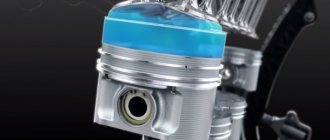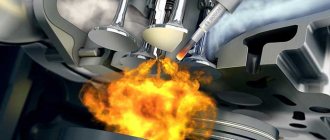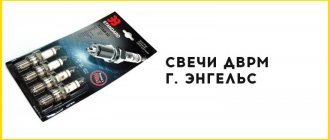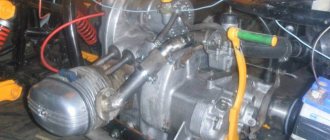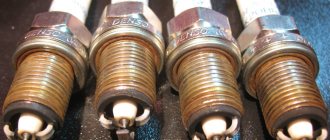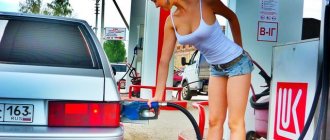The question of comparison in terms of “which is better” between injection and carburetor fuel supply has not been raised for a long time. There are fewer cars equipped with a carburetor every day, and new ones are no longer produced.
Novice motorists do not understand the structure of a car engine, fuel supply system, etc. The terms “carburetor” and “injector” mean nothing to them. Inexperienced motorists do not see the difference between their purposes. Those who buy a new car no longer face the question of which is better: a carburetor or an injector. They don’t need to know anything about the carburetor, since it has long been discontinued and does not pass the Euro-3 environmental standard.
This is associated with the massive transition of automakers to cars with an injection power system. The requirements for exhaust gas cleaning are becoming higher, and the carburetor cannot meet them.
But this is not the only reason for abandoning carburetors. Compared to an injector, it has many disadvantages and few advantages.
How does a carburetor work?
The device is intended for gasification of the mixture, a kind of mixing. The operating scheme is not particularly complicated; the float chamber, which contains fuel, is connected to the chambers through jets, and gasoline is supplied to the intake manifold. The float chamber of the carburetor is connected to the fuel line; the level of the combustible mixture is controlled by a needle assembly.
1. Idle jet; 2. Mixture quality screw; 3. Main fuel jet; 4. Throttle valve; 5. Needle; 6. Needle jet; 7. Hole in the sub-piston cavity; 8. Diaphragm; 9. Channel from the auxiliary filter; 10. Vacuum piston.
The air chamber consists of a throttle, atomizer and diffuser - these are the main systems that supply the engine combustion chambers with gasoline. Additional upgrades that control the start of a cold engine, an economizer, and an accelerator pump were installed according to the needs and scope of operation of the unit. Due to the vacuum, a working mixture is supplied to the cylinders, which sets the unit in motion.
Summarizing
- In carburetor systems, the fuel mixture enters the engine by suction; in injection systems, it is supplied under pressure through injectors using the injection method.
- The carburetor system is unstable, but the injector is more predictable.
- The injector works equally well in any weather; the carburetor does not like temperature changes or severe frosts.
- The injector does not pollute the atmosphere as much.
- A fuel-injected car accelerates faster.
- The carburetor consumes up to 40% more fuel.
- The injector rarely breaks, but its repair is more expensive.
- The carburetor is not so demanding on the quality of gasoline.
Seal
Operating principle of the injector
Injection supply of a combustible mixture is more modern and efficient in engine operation. The advantages and differences between an injector and a carburetor are that an electronic control unit is responsible for supplying gasoline to the cylinders, which doses the mixture depending on the type of load. The carburetor and the injector perform the same functions - they supply gasoline to the cylinders. The injection design works due to many sensors installed on the car.
The principle of operation of the injector: 1 - fuel tank; 2 - electric fuel pump; 3 - fuel filter; 4 — fuel pressure regulator; 5 - nozzle; 6 — electronic control unit; 7 — mass air flow sensor; 8 — throttle position sensor; 9 — coolant temperature sensor; 10 — XX regulator; 11 — crankshaft position sensor; 12 — oxygen sensor; 13 — neutralizer; 14 — knock sensor; 15 — adsorber purge valve; 16 - adsorber.
Injectors supply the combustible mixture directly to the cylinders; this type of engine equipment with gasoline is used in almost all modern power units. The check valve is responsible for maintaining the fuel level increased by the fuel pump into the fuel line. The design and difference of the nozzles consists of a solenoid valve, a spring, and a spray system.
Various types of gasoline supply are used in injection systems:
- Mono injection (single-point), the cheapest option, is installed on small-volume power units in order to save fuel;
- Distributed (multipoint) has several spray systems to more completely saturate the cylinders with the mixture;
- Direct or direct injection is installed on racing cars.
The amount of gasoline supplied to the cylinders depends on several parameters. Engine load, engine temperature, amount of nitrogen oxide in exhaust gases, air flow. The crankshaft position sensor acts as a reference for supplying fuel at the right time and cylinder. The position of the throttle valve determines the amount of combustible mixture supplied by the injection system; which is better, a carburetor or an injector.
Fuel consumption of carburetor and injection VAZs
| Brand VAZ | Power, hp | Average fuel consumption VAZ | City | Route |
| liter/100 km | ||||
| VAZ 2101 (1.2, carburetor) | — | 10.5 | 11 | |
| 90 km/h=7.5 | ||||
| 120 km/h=10 | ||||
| VAZ 2102, 2103 (1.5, Carburetor) | 71 | 11 | 11.5 | |
| 90 km/h=7.2 | ||||
| 120 km/h=9.8 | ||||
| 2106 (1.57 engine, carburetor, four-speed gearbox) | 76.4 | 9.5 | 10.5 | 8.5 |
| 2106 (1.45 engine, carburetor, four-speed gearbox) | 73.5 | 9.9 | 10.8 | 9.0 |
| 2106 (engine 1.6, injector) | — | 8.4 | 9.8 | 7 |
| 2105 (1.3, carburetor) | 64 | 9.1 | 10.2 | 8.1 |
| 2105 (1.5, carburetor, four-speed gearbox) | 71.1 | 8.8 | 9.5 | 8.0 |
| 2107 (1.6, injector) | — | 7.8-9.8 | 9-11.5 | 6.7-8.2 |
| 2107 (1.6, carburetor) | — | 8.9 | 10.2 | 7.5 |
| 2107 (1.5, carburetor) | — | 8.3 | 9.6 | 7.0 |
| 2108, 2109, 21099 (1.5, carburetor) | 72 | 9.1 | 10.1 | 8.2 |
| 21083, 21093, (1.5, injector) | 72 | 7.6 | 8.5 | 6.7 |
| 2110, 2111, 2112 (1.5, carburetor) | 67.7 | 9.5 | 10.5 | 8.4 |
| 2110, 2111, 21124 (1.5, injector) | 72 | 7.9 | 8.7 | 7.0 |
| 2113, 2114, 2115 (1.5, injector) | 72 | 7.6 | 8.5 | 6.7 |
| Lada Granta (8 valve) | 80 | 7.0 | 8.3 | 5.8 |
| Lada Granta (8 valve) | 90 | 7.7 | 9.3 | 6.1 |
| Lada Granta (16 valve) | 98, 106, 120 | 8.1-10.1 | 9.2-11.2 | 7-9 |
| Lada Kalina 21117, 21118, 21119 (1.4 engine) | — | 6.9 | 7.8 | 6.0 |
| Lada Kalina 21118, 21119 (engine 1.6) | — | 7.2 | 8.1 | 6.3 |
| Lada Priora (1.6) | 90 | 7.6 | 8.8 | 6.5 |
| Lada Priora (1.6, 16 valve) | 106 | 8.6 | 9.5 | 7.7 |
| Lada Vesta 21179 (1.8, 16 valve) | 123 | 8.5-10.5 | 9.5-11.5 | 7.5-9.5 |
| Lada Vesta 21129 (1.6, 16 valve) | 106 | 8-10 | 9.0-11.0 | 7.0-9.0 |
| Lada x-Ray (X-ray, 1.6, 16 valves) | 110 | 7.9 | 8.8 | 7.0 |
| Lada x-Ray (X-ray, 1.8, 16 valves) | 122 | 8.1 | 9.1 | 7.2 |
| Lada Largus (1.6, 8 valve) | 90 | 8.6 | 9.5 | 7.7 |
| Lada Largus (1.6, 16 valve) | 105 | 8.2 | 9.0 | 7.5 |
| VAZ 21213 (Niva, 1.7, carburetor) | — | 11.5 | 13.0 | 10.0 |
| VAZ 21214 (Niva, 1.7, injector) | — | 9.8 | 11.0 | 8.5 |
| VAZ 2131 (Niva, 1.8, injector) | — | 11.1 | 12.8 | 9.5 |
Share with friends on social networks:
Telegram
Main differences between systems
The purpose of both systems is to saturate the cylinders with a combustible mixture. The system pre-determines and prepares the mixture for delivery to the engine; inefficient fuel distribution affects overall consumption and the environment. Which is better, a carburetor or an injector? The first is popular in remote areas from services, as they can be adjusted without specialized tools. What is the difference between an injector and a carburetor is found out by many car owners before purchasing a new or used iron friend.
It is becoming increasingly rare to see cars with single injection on the market, as the automotive industry is flooded with power units with a modern fuel supply system. What is the difference between an injector and a carburetor, that the amount of gasoline is supplied in a precisely dosed form under certain loads, which has a positive effect on consumption. An injector or a carburetor have differences and features that pose a serious choice for the future owner.
Injection system
The use of an injection system in cars has a considerable number of advantages.
The carburetor, which has been used for a long time in the production of power units, remains the best, but has been replaced by a more modern design for a number of reasons:
- Efficiency is achieved by supplying gasoline at the required dosage, depending on the loads and operating mode, what is the difference between an injector and a carburetor;
- The ambient temperature does not affect engine starting; the ECU controls the amount of fuel mixture supplied when the engine is cold;
- Dynamic performance is significantly higher, especially at high speeds.
Before drawing conclusions about whether an injector or a carburetor is better for the VAZ 2109, you should pay attention to some difficulties. The modern version is not demanding on gasoline consumption and has easier starting in winter. However, with long-term operation, the structure is subject to expensive repairs, or even replacement of components.
Common pros and cons:
- The fuel used when operating the units must be of a higher quality than in carburetor units, otherwise the injectors will become clogged and the car will lose its dynamic properties;
- Maintenance and replacement of components involves considerable financial costs.
Carburetor type of fuel mixture supply
The most common fuel injection system, especially on cars produced by the domestic auto industry, is carburetor. Due to the possibility of doing it yourself, far from a car service center, the conclusion is that it is better to choose a carburetor or injector for the VAZ 21099.
Significant pros and cons of this type of combustible mixture supply:
- Replacing the device with a complex will cost less than an injection system; this does not affect the cost of a used car;
- The carb is less demanding on the quality of gasoline; timely replacement of the fuel and air filter will make it possible to drive for a long time without maintenance;
- Repairs and adjustments do not require computer diagnostics; you can make the adjustments in the garage yourself.
Naturally, the injector and carburetor are used in different environments, under increased loads. Old-fashioned systems have significant disadvantages during operation, so it is worth weighing the pros and cons before deciding whether a carburetor or an injector is better.
Negative aspects of carburetors:
- The difference is that starting in cold weather is carried out only mechanically, by pulling the choke out of the car;
- Fuel consumption is much higher, since the combustible mixture is supplied evenly under different operating modes;
- The slightest, as well as large shifts in tuning are a consequence of unstable operation of the internal combustion engine.
Summing up the debate about whether a carburetor or an injector is better, it should be noted that each of the developments requires proper maintenance during operation. In severe conditions, components should be cleaned and filters replaced more often than described in the regulations. Timely maintenance will give you confidence and reliability when operating your car.
Reviews from people
Volkov Mikhail
“A friend advised me to install an injector, but I was put off by the fact that fixing it is expensive, so I ended up installing an old carburetor. I regretted it within a week. There is a terrible smell of exhaust gases in the car, there is a constant overflow. In general, I should have listened to the advice. Now my 21 07 has a modern injector.”
Zakhar Magomaev
“I live in a village and a decent service station is far away. I decided to install an injector for myself only for the reason that it can be easily installed; I take care of it and clean it myself. If it were a carburetor, I’m afraid it would be difficult to drive into the city. The option installed in my car constantly has to be cleaned, but I do it myself, without outside help.”
Timofey Zlatoustov
“The car should drive well, and even if investments are needed in it, they should not be permanent. I have never regretted that I installed an injection engine. I've been driving it for 3 years now. Once every 120,000 km. I clean the filter and that’s it.”
Daniil Skolkov
“The injector and carburetor seem to perform the same function, but on the road they behave completely differently. My friend had an old model, which is only installed on ancient cars, but I have an injector. After I switched from mine to a friend’s car, I felt the difference. Firstly, there is a terrible smell in the cabin; it is very difficult to stay in a closed space for a long time. Also, fuel overflow, the % of which is high. My car started the third time and all this time gasoline was supplied in the usual volume. In general, problems begin in these little things. Personally, I wouldn’t trade a proven modern injection engine for anything!”
Alteration of the type of fuel mixture supply
To improve a car operated in urban conditions, conversion to an injector is most suitable. The car owner will have to modify, purchase many parts and kits to achieve the result. At the preparation stage, you should have all the necessary spare parts, disassemble the front part of the car for convenient work.
Draining liquids, disassembling the carburetor, the future injection system and the fuel line are the basis for starting work; it is necessary to check the differences between the units. The VAZ power supply system is changed to an identical injection line; the cylinder head and intake manifold are replaced in most cases.
Carrying out a replacement requires certain skills, a determination of whether a carburetor or an injector is better for the car owner, as well as an approach to work. If you do not have enough experience, tools and training, you should contact specialists at a qualified car service center.
If you have any questions, watch this video, the answer to the question of what is better is a carburetor or an injector:
Best driving instructors:
Driving instructor Galina Manual transmission: Chevrolet Lanos Trains in Vidnoye
Driving instructor Marina Automatic transmission: Kia Cerato Manual transmission: Chevrolet LanosTeaches in the Northern Administrative District, Dolgoprudny
Automotive instructor Irina Automatic transmission: Kia Cerato Trains in North-Western Administrative District, Closed Joint-Stock Company
Driving instructor Natalya Automatic transmission: Kia Spectra Teaches in the Eastern Administrative District, Balashikha, Reutov
Driving instructor Oleg Automatic transmission: Chevrolet Lacetti Manual transmission: Chevrolet LanosTeaches in the Northern Administrative District, Dolgoprudny
Driving instructor Yana Automatic transmission: Kia Spectra Trains in Northern Administrative Okrug, Dolgoprudny
Driving instructor Yulia Automatic transmission: Chevrolet Lacetti Manual transmission: Chevrolet LanosTrains in the Eastern Administrative District, South-Eastern Administrative District, Lyubertsy, Reutov, Zheleznodorozhny
Automotive instructor Svetlana Automatic transmission: Chevrolet Lacetti Trains in Northwestern Administrative District
Driving instructor Tatyana Manual transmission: Chevrolet Lanos Automatic transmission: Kia SpectrTeaches in Krasnogorsk
Automotive instructor Peter Manual: Daewoo Nexia Trains in Northwestern Administrative District
Driving instructor Oksana Automatic transmission: Hyundai Accent Manual transmission: Chevrolet LanosTeaches in North-Eastern Administrative District, Mytishchi, Korolev, Pushkin
Driving instructor Dmitry Automatic transmission: Volkswagen Golf Manual transmission: Chevrolet Lanos Trains in North-East Administrative District, Northern Administrative District, North-Western Administrative District, Dolgoprudny
Driving instructor Oksana Automatic transmission: Kia Spectra Manual transmission: Chevrolet Lanos Trains in the Southern Administrative District, South-Western Administrative District, Vidnoye, Podolsk
Driving instructor Ekaterina Automatic transmission: Hyundai Accent Manual transmission: Daewoo Nexia Trains in North-Western Administrative District, Northern Administrative District, Khimki, Dolgoprudny
Automotive instructor Dmitry Manual transmission: Lada Granta Trains in the South-Eastern Administrative District, Lyubertsy
Source
Candles
There is also some difference between the spark plugs of a carburetor and injection engine. Candles differ in gap and heat rating. For engines with a carburetor system, the gap should be smaller, for injection power units, correspondingly, larger. Heat number is a value characterizing the uncontrolled process of ignition of the emulsion from the hot parts of the candle. According to their thermal characteristics, candles are divided into:
- for cold ones (number 20 or more), intended for highly accelerated units;
- to medium (17-19);
- for hot ones (11-14), used for low-power internal combustion engines;
- to unified (11-20).
The heat rating increases with increasing power and volume of the power plant. Depends on the compression ratio: the higher it is, the higher the heat rating should be. It is necessary to select spark plugs based on the requirements of the manufacturer of a particular engine.
Which is better - diesel or petrol?
You can often hear the question - which engine is more profitable and better - carburetor or diesel? Let's try to understand this difficult issue, and start by comparing the designs of these heat engines and analyzing their fundamental differences.
The main differences between carburetor engines and diesel engines are the method of preparing the combustible mixture (a mixture of fuel with air oxygen) and the method of ignition. In a carburetor engine, the combustible mixture, which is usually a mixture of gasoline and air, is prepared outside the engine cylinders - in an external mixing device - the carburetor (external mixture formation). When the intake valve is open and the piston moves to the bottom dead current (intake stroke), a vacuum is created in the cylinder, and air is sucked in through the carburetor air pipe. Moving through the carburetor diffusers, the air is mixed with gasoline, which is sucked in and sprayed from the jets connecting the float chamber to the diffusers (based on the principle of a vacuum spray). In this form, the mixture, ready for ignition, enters the cylinder, where, during the compression process, it is finally mixed and heated. Next, the mixture is ignited by a spark plug and the power stroke is completed.
In a diesel engine, the combustible mixture is prepared directly in the engine cylinders (internal mixture formation) - first, air enters the cylinder through the intake valve, and then, when the air is strongly compressed and heats up from compression, a portion of fuel is injected into the cylinder using an injector. Ignition occurs without an extraneous source of flame (spark) and the engine performs a power stroke, that is, it performs useful mechanical work using the thermal energy of the burning fuel. The compression ratio in diesel engines is much higher than the compression ratio in carburetor engines, which makes self-ignition of the working mixture possible.
The two concepts should not be confused - “working mixture” and “combustible mixture”. The combustible mixture is a mixture of clean air and fuel, and the working mixture also contains exhaust gases remaining in the cylinder after it has been purged through the exhaust valve. That is, it is not the combustible mixture that ignites in the cylinder, but the working mixture, since it is practically impossible to completely remove the exhaust gases.
Based on the analysis of the fundamental differences between diesel and carburetor engines, we will try to evaluate their advantages and disadvantages for an objective comparison.

